Variable-Gain Super-Twisting Sliding Mode Damping Control of Series-Compensated DFIG-Based Wind Power System for SSCI Mitigation
Abstract
1. Introduction
2. Series-Compensated DFIG-Based Wind Power System Modeling
3. SSCI Analysis and Control Design
3.1. SSCI Mechanism
3.2. Control Design
4. Time-Domain Simulation
5. Conclusions
Author Contributions
Funding
Institutional Review Board Statement
Informed Consent Statemen
Data Availability Statement
Conflicts of Interest
References
- Mahalakshmi, R.; Thampatty, K.C.S. Design and implementation of modified RSC controller for the extenuation of sub-synchronous resonance oscillations in series compensated DFIG-based WECS. Int. Trans. Electr. Energy Syst. 2020, 30, e12396. [Google Scholar] [CrossRef]
- Han, Y.; Ma, R. Adaptive-Gain second-order sliding mode direct power control for wind-turbine-driven dfig under balanced and unbalanced grid voltage. Energies 2019, 12, 3886. [Google Scholar] [CrossRef]
- Suppioni, V.P.; Grilo, A.P.; Teixeira, J.C. Coordinated control for the series grid side converter-based DFIG at subsynchronous operation. Electr. Power Syst. Res. 2019, 173, 18–28. [Google Scholar] [CrossRef]
- Huang, P.H.; El Moursi, M.S.; Xiao, W.; Kirtley, J.L. Subsynchronous resonance mitigation for series-compensated DFIG-based wind farm by using two-degree-of-freedom control strategy. IEEE Trans. Power Syst. 2014, 30, 1442–1454. [Google Scholar] [CrossRef]
- Fan, L.; Zhu, C.; Miao, Z.; Hu, M. Modal analysis of a DFIG-based wind farm interfaced with a series compensated network. IEEE Trans. Energy Convers. 2011, 26, 1010–1020. [Google Scholar] [CrossRef]
- Jiao, Y.; Li, F.; Dai, H.; Nian, H. Analysis and mitigation of sub-synchronous resonance for doubly fed induction generator under VSG control. Energies 2020, 13, 1582. [Google Scholar] [CrossRef]
- Revel, G.; Alonso, D.M. Subsynchronous interactions in power networks with multiple DFIG-based wind farms. Electr. Power Syst. Res. 2018, 165, 179–190. [Google Scholar] [CrossRef]
- Yang, J.-W.; Sun, X.-F.; Chen, F.-H.; Lao, K.; He, Z.-Y. Subsynchronous resonance suppression strategy for doubly fed induction generators based on phase-shift average of rotor current. Int. Trans. Electr. Energy Syst. 2019, 29, e2831. [Google Scholar] [CrossRef]
- Karunanayake, C.; Ravishankar, J.; Dong, Z.Y. Nonlinear SSR damping controller for DFIG Based wind generators interfaced to series compensated transmission systems. IEEE Trans. Power Syst. 2020, 35, 1156–1165. [Google Scholar] [CrossRef]
- Ghaffarzadeh, H.; Mehrizi-Sani, A. Mitigation of subsynchronous resonance induced by a type III wind system. IEEE Trans. Sustain. Energy 2020, 11, 1717–1727. [Google Scholar] [CrossRef]
- Shair, J.; Xie, X.; Yan, G. Mitigating subsynchronous control interaction in wind power systems, Existing techniques and open challenges. Renew. Sustain. Energy Rev. 2019, 108, 330–346. [Google Scholar] [CrossRef]
- Velpula, S.; Thirumalaivasan, R.; Janaki, M. A Review on subsynchronous resonance and its mitigation techniques in DFIG based wind farms. Int. J. Renew. Energy Res. 2018, 8, 2275–2288. [Google Scholar]
- Wang, L.; Sun, X.; You, Y. DFIG wind farm modeling for subsynchronous control interaction Analysis. IEEJ Trans. Electr. Electron. Eng. 2018, 13, 253–261. [Google Scholar] [CrossRef]
- Yousuf, V.; Ahmad, A. Unit template-based control design for alleviation and analysis of SSR in power system using STATCOM. Electr. Power Compon. Syst. 2019, 47, 1805–1813. [Google Scholar] [CrossRef]
- Tung, D.D.; Dai, V.L.; Quyen, L.C. Subsynchronous resonance and facts-novel control strategy for its mitigation. J. Eng. 2019, 1–14. [Google Scholar] [CrossRef]
- Bhushan, R.; Chatterjee, K. Effects of parameter variation in DFIG-based grid connected system with a FACTS device for small-signal stability analysis. IET Gener. Transm. Distrib. 2017, 11, 2762–2777. [Google Scholar] [CrossRef]
- Boopathi, V.P.; Devi, R.P.K.; Ramanujam, R.; Dasan, S.G.B. Investigation of subsynchronous oscillations in grid connected Type-2 wind farm and its mitigation using STATCOM. J. Electr. Eng. 2017, 17, 10. [Google Scholar]
- Fan, L.; Kavasseri, R.; Miao, Z.L.; Zhu, C. Modeling of DFIG-based wind farms for SSR analysis. IEEE Trans. Power Deliv. 2010, 25, 2073–2082. [Google Scholar] [CrossRef]
- Fan, L.; Miao, Z. Mitigating SSR using DFIG-based wind generation. IEEE Trans. Sustain. Energy 2012, 3, 349–358. [Google Scholar] [CrossRef]
- Li, Y.; Fan, L.; Miao, Z. Replicating real-world wind farm SSR events. IEEE Trans. Power Deliv. 2020, 35, 339–348. [Google Scholar] [CrossRef]
- Ghafouri, M.; Karaagac, U.; Karimi, H.; Jensen, S.; Mahseredjian, J.; Faried, S.O. An LQR controller for damping of subsynchronous interaction in DFIG-based wind farms. IEEE Trans. Power Syst. 2017, 32, 4934–4942. [Google Scholar] [CrossRef]
- Leon, A.E.; Solsona, J.A. Sub-Synchronous interaction damping control for DFIG wind turbines. IEEE Trans. Power Syst. 2014, 30, 419–428. [Google Scholar] [CrossRef]
- Chen, A.; Xie, D.; Zhang, D.; Gu, C.; Wang, K. PI parameter tuning of converters for sub-synchronous interactions existing in grid-connected DFIG wind turbines. IEEE Trans. Power Electron. 2019, 34, 6345–6355. [Google Scholar] [CrossRef]
- Yao, J.; Wang, X.; Li, J.; Liu, R.; Zhang, H. Sub-Synchronous resonance damping control for series-compensated DFIG-based wind farm with improved particle swarm optimization algorithm. IEEE Trans. Energy Convers. 2019, 34, 849–859. [Google Scholar] [CrossRef]
- Rahimi, M. Dynamic performance assessment of DFIG-based wind turbines: A review. Renew. Sustain. Energy Rev. 2014, 37, 852–866. [Google Scholar] [CrossRef]
- Djoudi, A.; Bacha, S.; Iman-Eini, H.; Rekioua, T. Sliding mode control of DFIG powers in the case of unknown flux and rotor currents with reduced switching frequency. Int. J. Electr. Power Energy Syst. 2017, 96, 347–356. [Google Scholar] [CrossRef]
- Chowdhury, M.A.; Mahmud, M.A.; Shen, W.; Pota, H.R. Nonlinear controller design for series-compensated DFIG-based wind farms to mitigate subsynchronous control interaction. IEEE Trans. Energy Convers. 2017, 32, 707–719. [Google Scholar] [CrossRef]
- Chowdhury, M.A.; Shafiullah, G.M. SSR mitigation of series-compensated DFIG wind farms by a nonlinear damping controller using partial feedback linearization. IEEE Trans. Power Syst. 2018, 33, 2528–2538. [Google Scholar] [CrossRef]
- Penghan, L.; Jie, W.; Fei, W.; Li, H. Nonlinear controller based on state feedback linearization for series-compensated DFIG-based wind power plants to mitigate sub-synchronous control interaction. Int. Trans. Electr. Energy Syst. 2019, 29, e2682. [Google Scholar] [CrossRef]
- Wang, Y.; Wu, Q.; Yang, R.; Tao, G.; Liu, Z. H∞ current damping control of DFIG based wind farm for sub-synchronous control interaction mitigation. Int. Trans. Electr. Energy Syst. 2018, 98, 509–519. [Google Scholar] [CrossRef]
- Ghafouri, M.; Karaagac, U.; Karimi, H.; Mahseredjian, J. Robust subsynchronous interaction damping controller for DFIG-based wind farms. J. Mod. Power Syst. Clean Energy 2019, 7, 1663–1674. [Google Scholar] [CrossRef]
- Xu, Y.; Zhao, S. Mitigation of subsynchronous resonance in series-compensated DFIG wind farm using active disturbance rejection control. IEEE Access 2019, 7, 68812–68822. [Google Scholar] [CrossRef]
- Liu, X.; Han, Y. Decentralized multi-machine power system excitation control using continuous higher-order sliding mode technique. Int. J. Electr. Power Energy Syst. 2016, 82, 76–86. [Google Scholar] [CrossRef]
- Susperregui, A.; Herrero, J.M.; Martinez, M.I.; Tapia-Otaegui, G.; Blasco, X. Multi-Objective optimisation-based tuning of two second-order sliding-mode controller variants for dfigs connected to non-ideal grid voltage. Energies 2019, 12, 3782. [Google Scholar] [CrossRef]
- Li, P.; Xiong, L.; Wu, F.; Ma, M.; Wang, J. Sliding mode controller based on feedback linearization for damping of sub-synchronous control interaction in DFIG-based wind power plants. Int. J. Electr. Power Energy Syst. 2019, 107, 239–250. [Google Scholar] [CrossRef]
- Li, P.; Xiong, L.; Wang, Z.; Ma, M.; Wang, J. Fractional-Order sliding mode control for damping of subsynchronous control interaction in DFIG-based wind farms. Wind Energy 2020, 23, 749–762. [Google Scholar] [CrossRef]
- Obeid, H.; Fridman, L.M.; Laghrouche, S.; Harmouche, M. Barrier function-based adaptive sliding mode control. Automatica 2018, 540–544. [Google Scholar] [CrossRef]
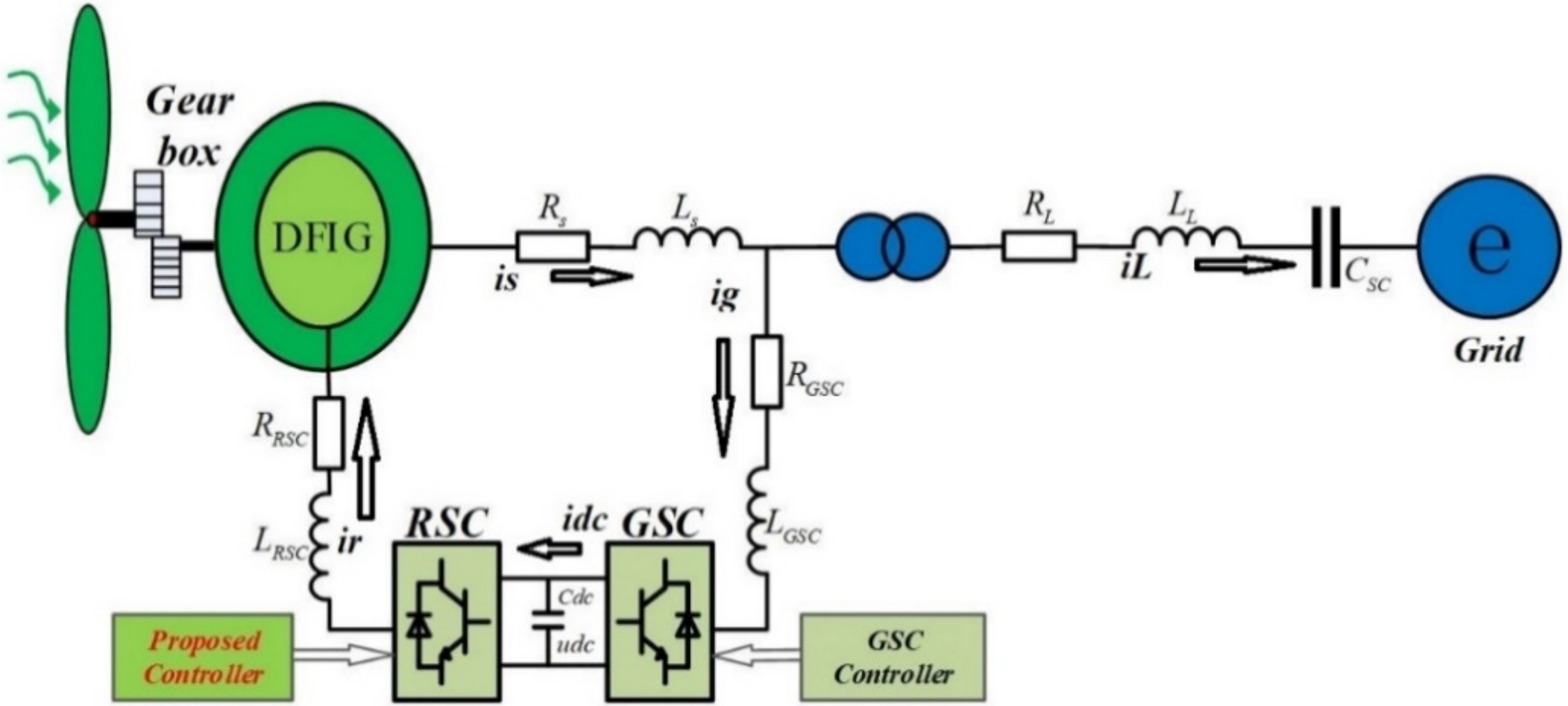
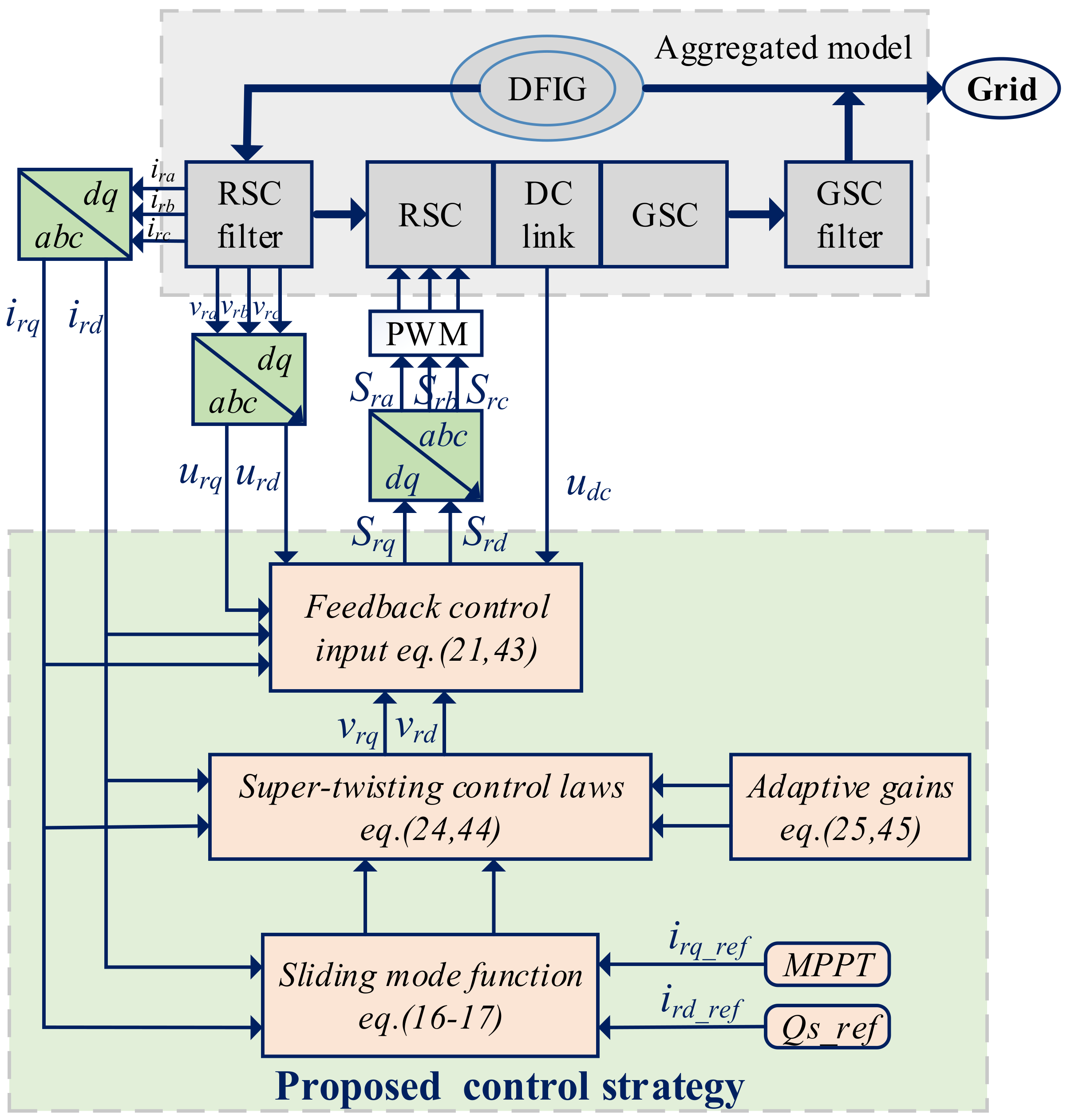



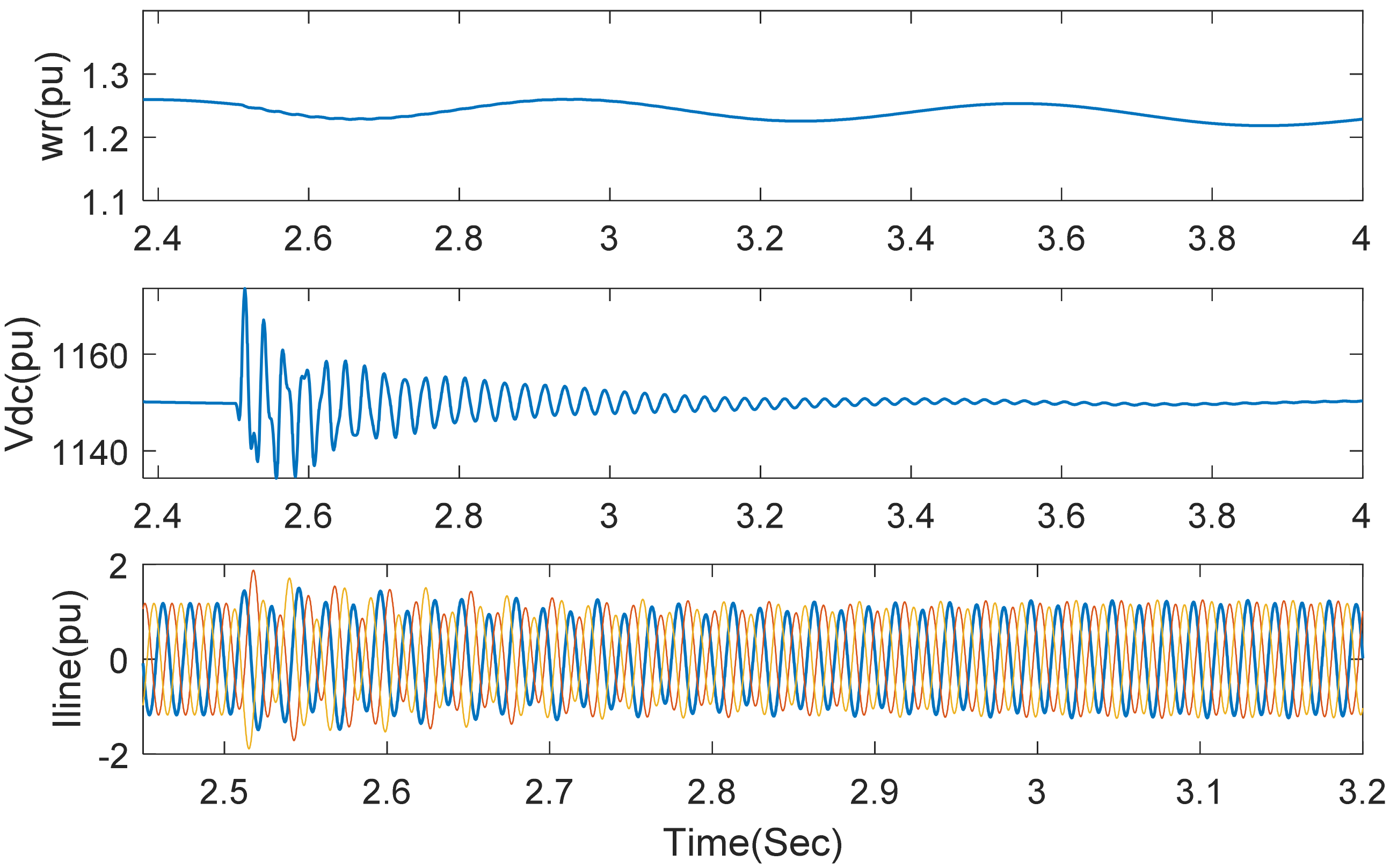
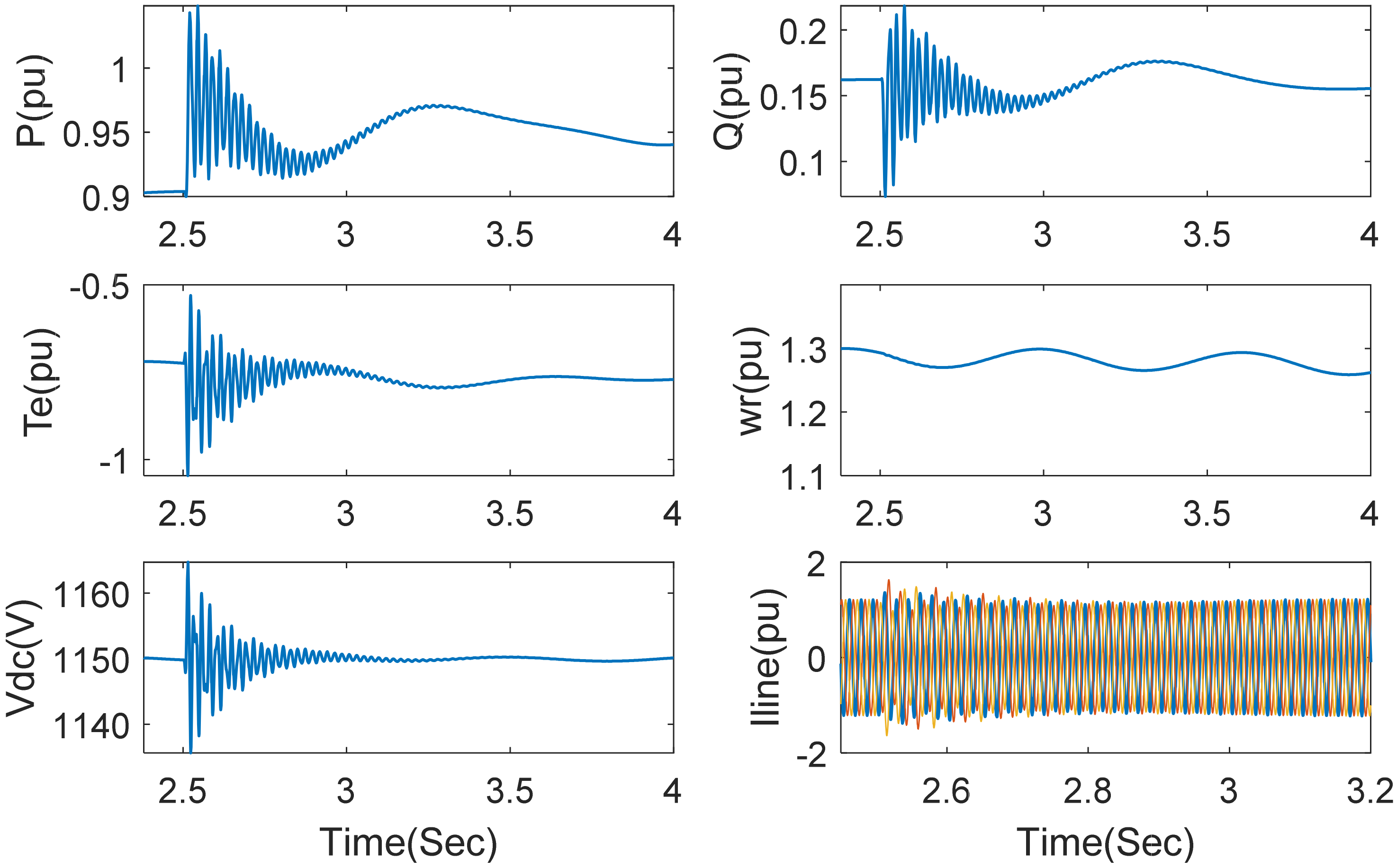

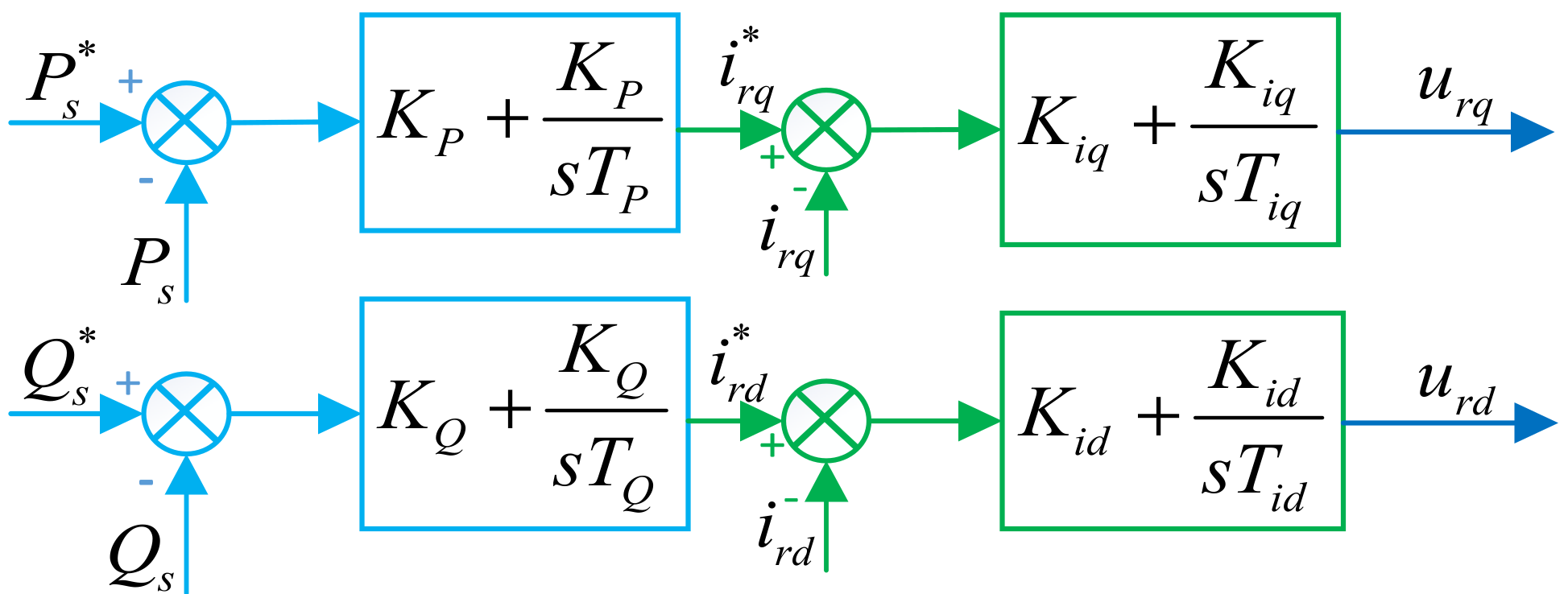


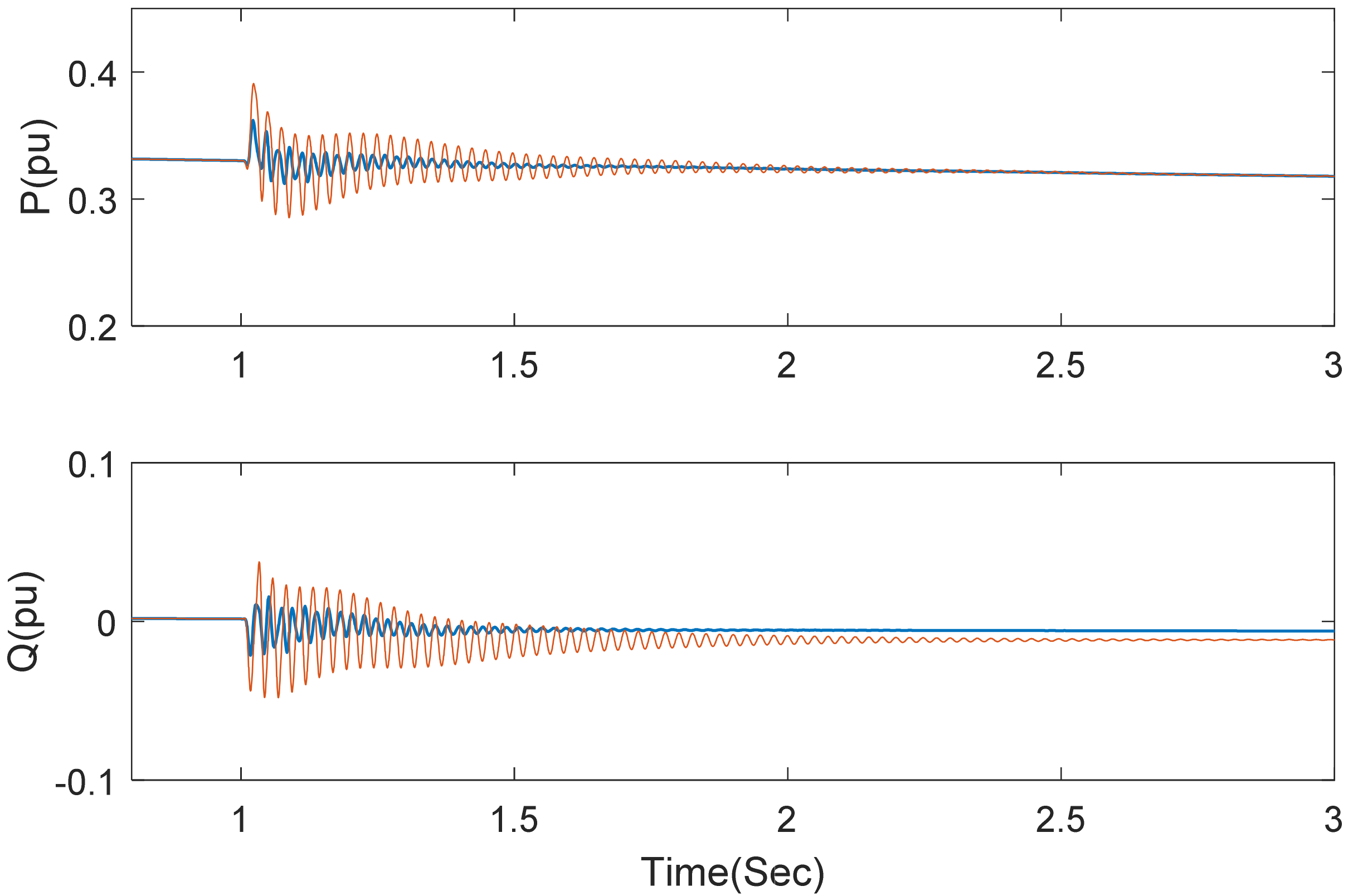
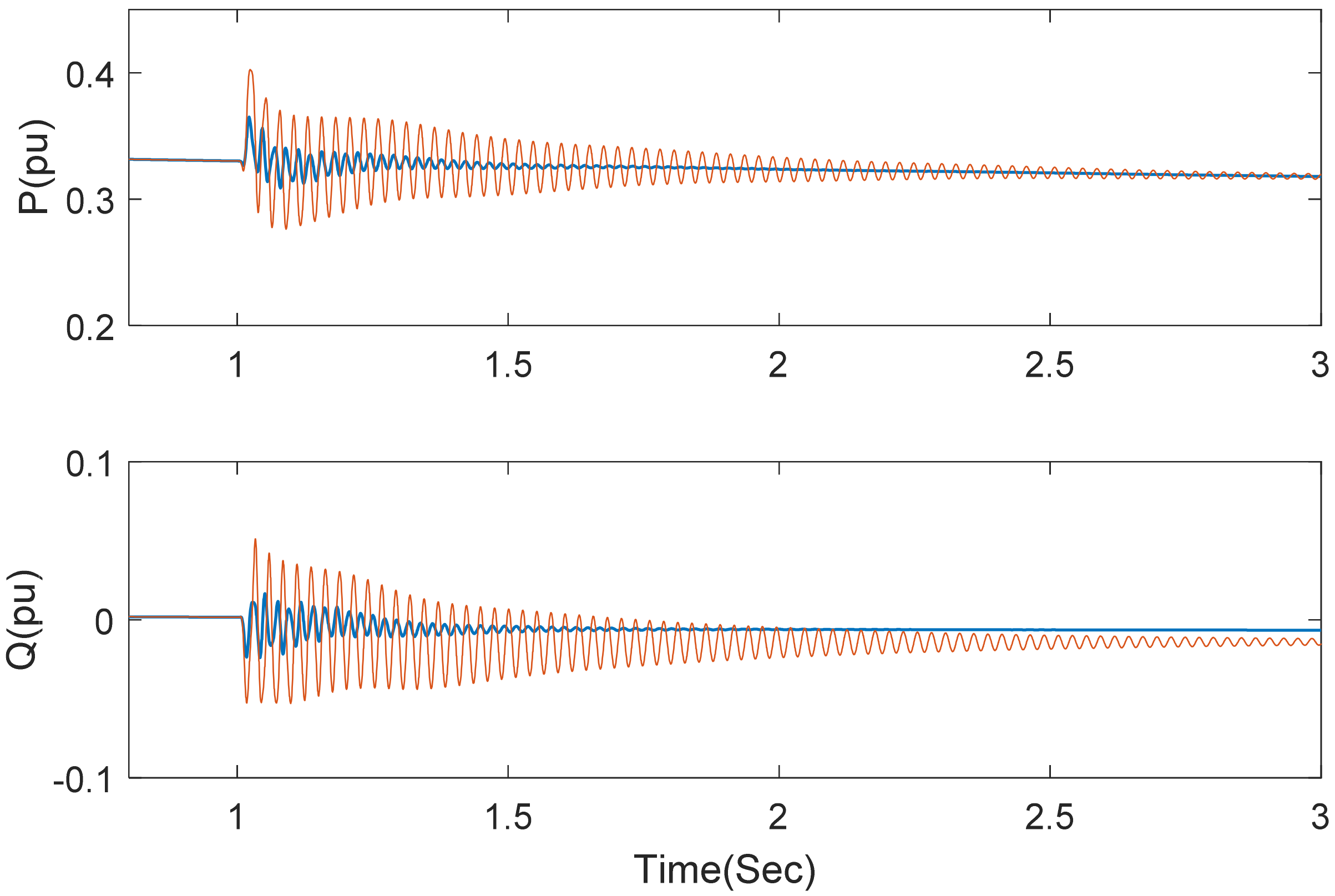
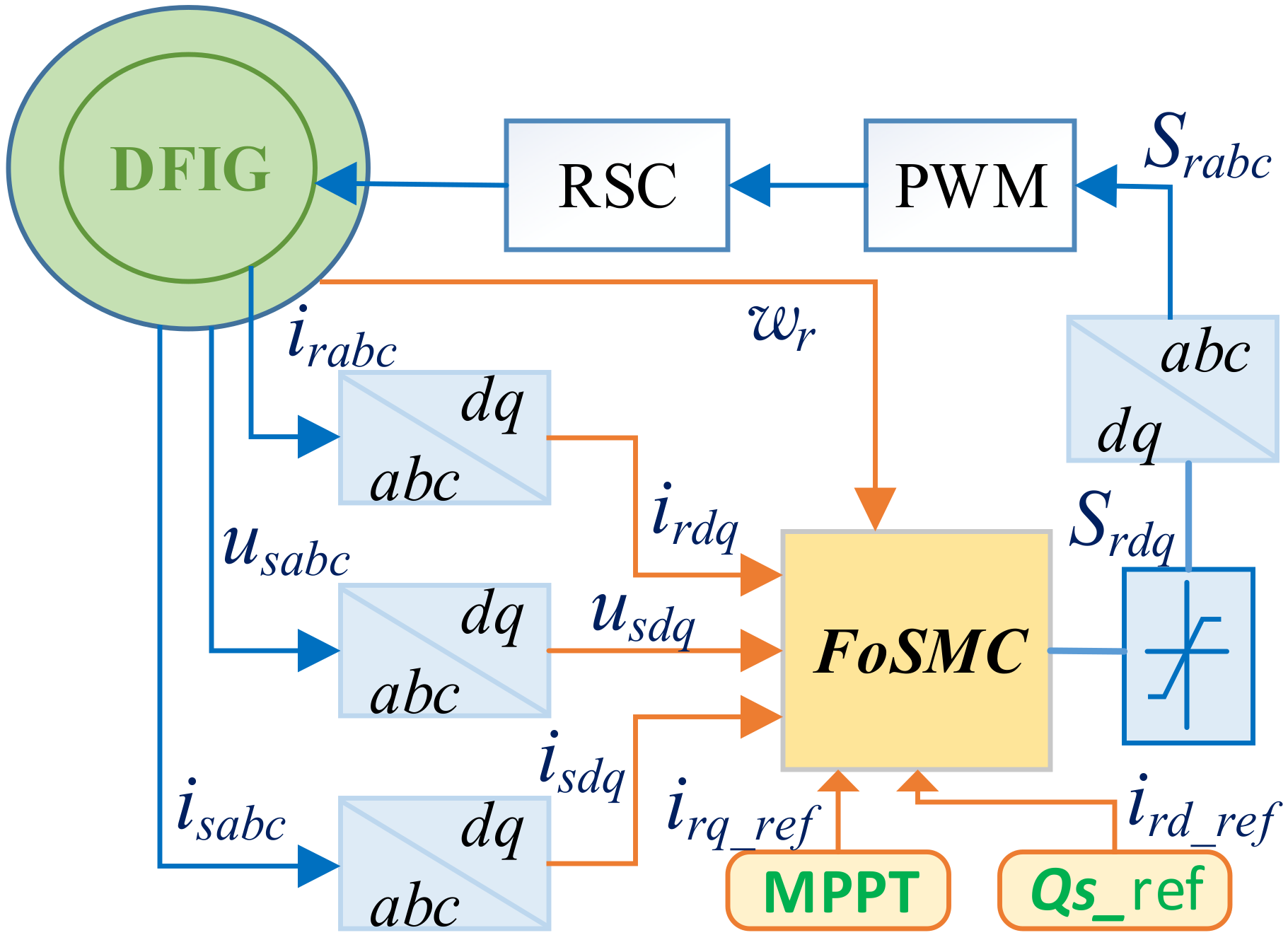
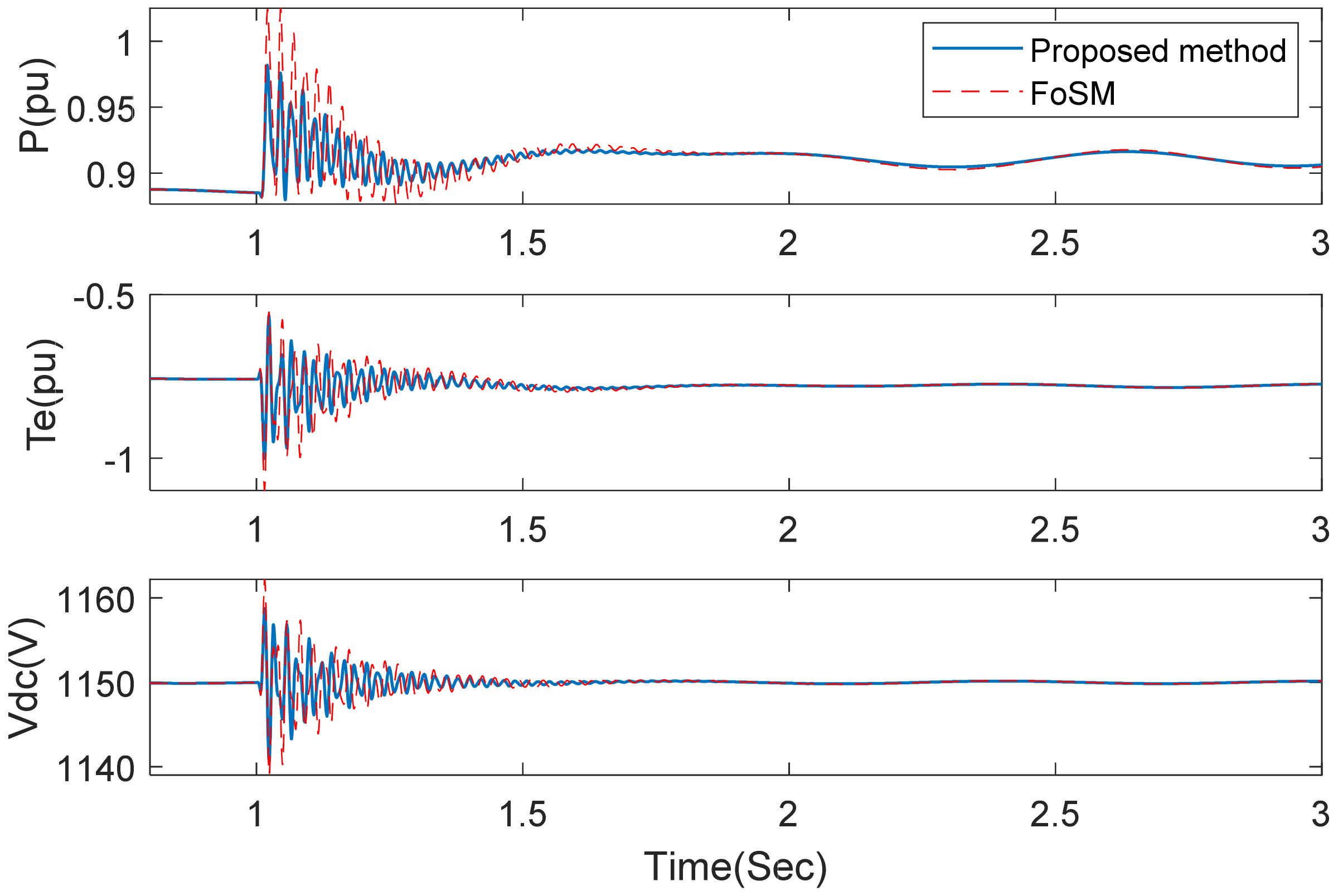
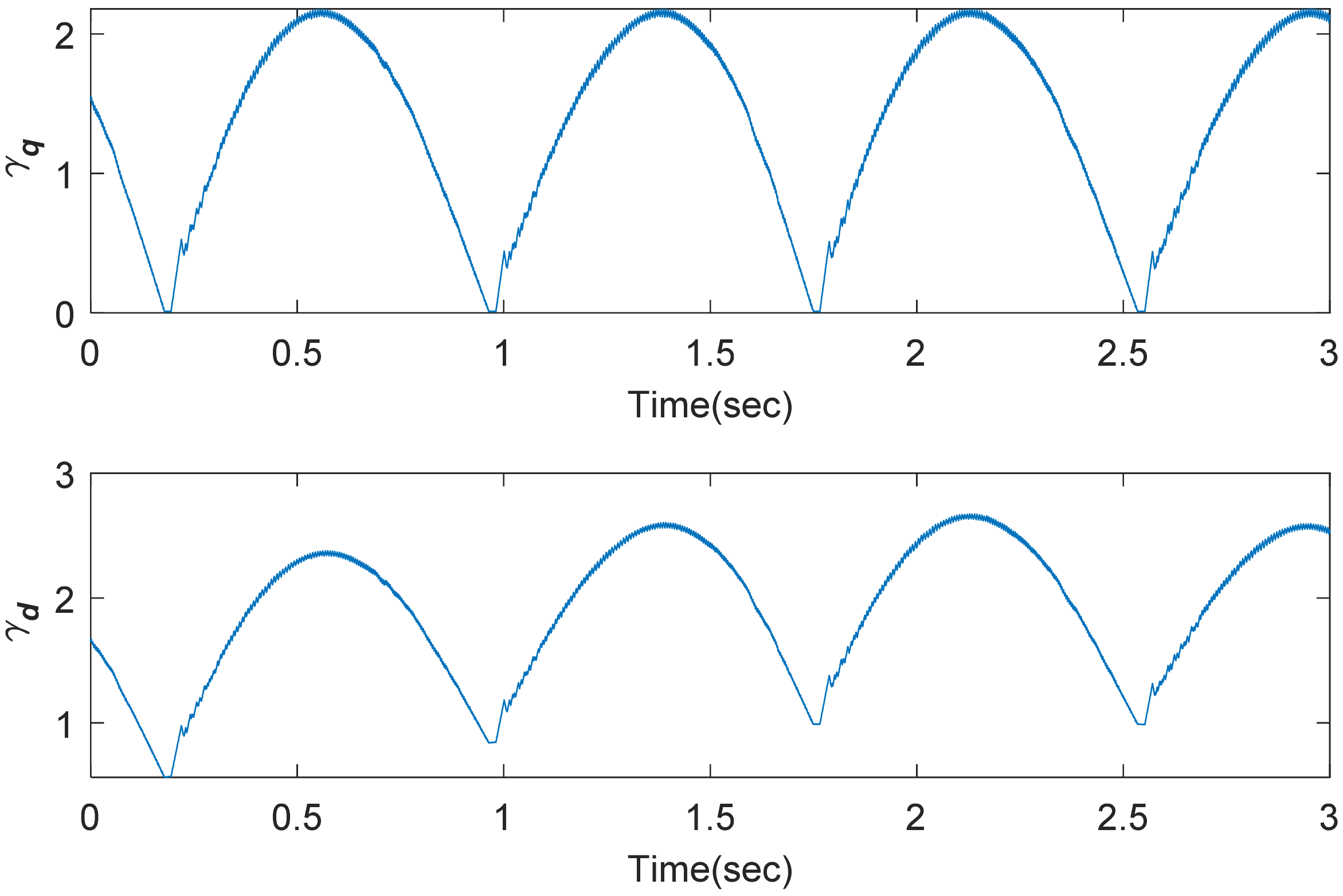
| Quantity | Value |
|---|---|
| Nominal power | 100 Mw |
| Rater voltage | 690 V |
| Rs | 0.0084 pu |
| Ls | 0.167 pu |
| HT | 2.5 pu |
| HG | 0.5 pu |
| Ks | 0.15 pu |
| RRSC | 0.0083 pu |
| LRSC | 0.1323 pu |
| RGSC | 0.0015 pu |
| LGSC | 0.151 pu |
| DC-lin capacitance | 10 mF |
| Nominal DC-link voltage | 1150 V |
| RL | 0.02 pu |
| LL | 0.0016 pu |
| CSC (at 45% compensation) | 42.61 uF |
| RMSurq | RMSurd | RMSeirq | RMSeird | |
|---|---|---|---|---|
| PI | 0.9061 | 0.8906 | 0.0591 | 0.0698 |
| SMC | 0.8037 | 0.7091 | 0.0506 | 0.0593 |
| VGSTSM | 0.6071 | 0.4921 | 0.0365 | 0.0361 |
Publisher’s Note: MDPI stays neutral with regard to jurisdictional claims in published maps and institutional affiliations. |
© 2021 by the authors. Licensee MDPI, Basel, Switzerland. This article is an open access article distributed under the terms and conditions of the Creative Commons Attribution (CC BY) license (http://creativecommons.org/licenses/by/4.0/).
Share and Cite
Ma, R.; Han, Y.; Pan, W. Variable-Gain Super-Twisting Sliding Mode Damping Control of Series-Compensated DFIG-Based Wind Power System for SSCI Mitigation. Energies 2021, 14, 382. https://doi.org/10.3390/en14020382
Ma R, Han Y, Pan W. Variable-Gain Super-Twisting Sliding Mode Damping Control of Series-Compensated DFIG-Based Wind Power System for SSCI Mitigation. Energies. 2021; 14(2):382. https://doi.org/10.3390/en14020382
Chicago/Turabian StyleMa, Ronglin, Yaozhen Han, and Weigang Pan. 2021. "Variable-Gain Super-Twisting Sliding Mode Damping Control of Series-Compensated DFIG-Based Wind Power System for SSCI Mitigation" Energies 14, no. 2: 382. https://doi.org/10.3390/en14020382
APA StyleMa, R., Han, Y., & Pan, W. (2021). Variable-Gain Super-Twisting Sliding Mode Damping Control of Series-Compensated DFIG-Based Wind Power System for SSCI Mitigation. Energies, 14(2), 382. https://doi.org/10.3390/en14020382




